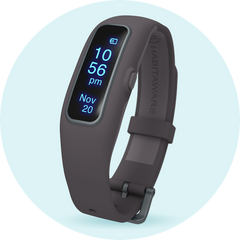By: Ellen Crupi, HabitAware Director of Awareness
What is Trichotillomania anyway?
The textbook clinical definition:
Trichotillomania (trik-o-til-o-MAY-nee-uh), also called hair-pulling disorder, is a mental disorder that involves recurrent, irresistible urges to pull out hair from your scalp, eyebrows, or other areas of your body, despite trying to stop.
- Recurrent pulling out of one's hair, resulting in hair loss.
- Repeated attempts to decrease or stop hair pulling
- The hair pulling cannot be better explained by the symptoms of another mental disorder (e.g., attempts to improve a perceived defect or flaw in appearance, such as may be observed in body dysmorphic disorder).
- The hair pulling or hair loss cannot be attributed to another medical condition (e.g., a dermatological condition).
- The disturbance causes clinically significant distress or impairment in social, occupational, or other important areas of functioning.
But what does that truly mean?
There is a great deal of unknown in the textbook definition. It doesn't help us understand why we repeatedly pull out our own hair, want to stop, try to stop, or why stopping is impossible. Nor does it tell us how to control or if even control is possible. It only explains the what. This definition has no insight, direction, hope or resolution
So let’s reset our mindset, starting with our definition of trichotillomania.
The HabitAware Definition of Trichotillomania:
The hands are the gateway to the mind. When the mind is restless, it leads to "restless" hands. And those restless hands find themselves pulling out our own hair. For one (1) in 20 Americans, this restlessness presents in the form of pulling out their hair, aka Trichotillomania, hair-pulling disorder.
Some with Trichotillomania pull scalp hair, while others pull out eyelashes, eyebrows, pubic hair, or hair from other areas of the body. Some pull only one site; like me, I am a scalp puller, while others might pull from multiple areas like the scalp, brows, and lashes.
Trichotillomania serves a purpose, yet the textbook definition doesn't say that. The purpose: Trichotillomania is a coping mechanism, helping us through uncomfortable situations, from anxiety to boredom. Trichotillomania does an excellent job of self-soothing us. Those favorable side effects are temporary, like the eye of the storm. Once the calm, trance-like feeling fades, the terrible long term side effects set in and leave in its wake the physical and mental scars.
Why do we pull? Because the repeated soothing movement helps our mind and body find emotional regulation or homeostasis. And the human brain craves balance.
Trauma, stress, anxiety, boredom, tiredness, concentration, or other emotional states might trigger Trichotillomania. Though soothing, Trichotillomania has terrible side effects affecting the body (bald patches, missing eyelashes, eyebrows) and mind (feelings of guilt, shame, fear, isolation, fear of being judged, depression, and anxiety).
While hair-pulling sounds painful, many report a sense of relief, even enjoyment, and satisfaction, making it very difficult to stop. In fact, we can’t “just stop” because Trichotillomania is a chronic health condition.
Let's look at other chronic medical conditions. Diabetes, asthma, and celiac disease, to name a few. What do these all have in common?
- They are persisting for a long time, or constantly recurring
- They are not our fault - we didn't choose to have a chronic condition
- There is no cure
- Control is possible
How many people have a Trichotillomania?
The TLC Foundation for Body Repetitive Behaviors estimates 1 in 20 experience trichotillomania in their lifetime. But it isn't an easy thing to know for sure. Trichotillomania is often self-reported, as such these numbers are likely higher.
You might feel as if you are the only one in the world with this behavior. Trust me when I say this:
YOU. ARE. NOT. ALONE.
Remember—approximately 1 in 20 people. There are likely people you know and love that are living with Trichotillomania, just like you.
All of us with Trichotillomania feel intense shame and guilt, often hiding our condition from family and friends for fear of being judged and fear of receiving no support. The result of this secrecy?
TRICHOTILLOMANIA IS ONE OF THE MOST COMMON HEALTH CONDITION YOU'VE NEVER HEARD, AND NOBODY WANTS TO TALK ABOUT IT.
Why do some people have Trichotillomania and others don't?
Trichotillomania is likely developed due to a combination of factors rather than one thing. Researchers have not discovered why or how it manifests. There is some evidence of a genetic component and a hormonal influence, as onset is usually early adolescence, coinciding with puberty. As with most disorders, there are exceptions, where children as young as six or older adults may develop Trichotillomania.
Anecdotally, we see more women than men talking about Trichotillomania on social media, attending support groups and joining the HabitAware Keen family.
Why might this be? Two words: Social Pressure. There is societal pressure for women to be beautiful. And what defines a woman’s beauty? Hair, skin, nails.
What about men? They can be bald and beardless without a second thought, right? Well, according to new research from Psychiatry Research, “Trichotillomania was equally common in both men and women.” Trichotillomania does not discriminate for gender, race, or social status.
Everyone, who wants to, deserves to take control.
Types of Trichotillomania
Trichotillomania is a compulsive, trance-like, behavior that falls within two types, as defined by the medical community:
- Focused means a person is goal-oriented and aware of their pulling, i.e., picking or pulling hair in front of a mirror, with or without tools, like tweezers.
- Automatic means the person is unaware of the pulling. This type typically occurs while doing other activities, such as watching TV, reading, studying, and driving.
While we might gravitate toward one way or the other, most experience a combination of both. The crux of the medical definition is the presence or absence of awareness of the pulling behavior.
As we say at HabitAware, "You can't change what you don't know is happening."
In Cognitive Behavioral Therapy (CBT), a gold standard of treatment, awareness is the first step.
You might be thinking: "Oh, I know when I'm pulling, so awareness is not my issue."
I say, not so fast. Awareness is slippery. Consider this:
And those chips! You knew you were eating chips with your friend, and you thought you had eaten only a handful. But as you close the bag, you realize that the two of you devoured the whole bag!
The same goes for our Trichotillomania. We think we are engaging in our pulling behavior for 10 minutes, and in reality, it's 45+ minutes. We believe we don't pull at work or school, but without awareness, we don’t know for certain.
So, It’s not just about being aware, it's also about having a sense of control over the pulling situation. In both focused and automatic pulling scenarios, there is still a lack of control.
Let’s reset to how WE categorize Trichotillomania:
Passive - Pulling while doing something else, such as reading, watching TV, driving, or as a passenger, working, and studying. Our hands have a mind of their own, and we are not aware until the damage is done. Even when we notice the hairs in our hand, and yell at ourselves to stop, our hands don’t listen. Out of control, we find ourselves back in a repetitive loop.
Active - Pulling with intention. Knowingly dropping what we are doing to achieve the goal of pulling, with or without tools, like tweezers or a mirror. The pulling pulls us in and we enter a trance-like state in which we lose a sense of how long it’s been. Despite knowing, we are not in control.
Why can't someone with Trichotillomania just stop?
Trichotillomania is a chronic medical condition. As with all chronic medical conditions you can't just stop. And believe me when I say this, if just stopping was the answer, then Trichotillomania wouldn't exist.
Here's another example from Dr. Lea Lis, The Shameless Psychiatrist. She says, "telling someone to just stop pulling is like telling someone to just stop being hungry...You can't! You can't just tell your body, stop being hungry and that hunger feeling, and biological need simply stops."
Stopping hunger is just a momentary thing. You eat, the hunger is gone, but once the food digests the hunger comes back. You can't just stop being hungry.
Putting it all together:
Understanding Trichotillomania is an important step towards healing.
Trichotillomania's medical definition tells you a partial story. We hope our explanation of Trichotillomania replaces the uncertainty with clarity. Now you know Trichotillomania:
- is a chronic health condition
- is Not your fault - you didn't choose to have a chronic condition
- doesn't discriminate between gender, race, or social status
- there is no cure, but control is possible
- there is passive pulling and active pulling
- awareness is a key to taking control
- you are not alone
- There is HOPE
Taking Control of Trichotillomania Begins with Keen AWARENESS
Taking control is possible. Tens of thousands of people all over the globe have taken control of Trichotillomania with HabitAware Keen Awareness. Keen2 is a smart bracelet - your awareness and response coach - helping YOU take control. It's a holistic system on your wrist, and in your pocket.
Now you know what Trichotillomania is and that there is hope. You can take control with the right mindset and with Keen2 Awareness and Response Coach!
About Keen2 by HabitAware
 HabitAware makes Keen2, a smart bracelet that helps manage nail biting, hair pulling, thumb sucking, and other subconscious behaviors. Customized gesture detection brings you into awareness and helps you develop healthier habits.
HabitAware makes Keen2, a smart bracelet that helps manage nail biting, hair pulling, thumb sucking, and other subconscious behaviors. Customized gesture detection brings you into awareness and helps you develop healthier habits.

